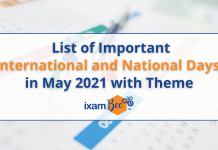Every year the budget is presented in the parliament by the finance minister. The Union Budget of India, also referred to as the Annual Financial Statement in Article 112 of the Constitution of India, is the annual budget of the Republic of India. The Government presents it on the first day of February so that it could be materialised before the beginning of the new financial year in April.
Knowing the budget is important for every aspirant who is preparing for the competitive exam. It has been seen over the time that most of the questions are framed from the budget presented in the parliament. In RBI Grade B 2021 exam the descriptive papers are introduced in Phase 2 for ESI & FM sections. These sections might have questions related to the budget 2021. To answer the same you must be aware of the key highlights.
Budget and Constitutional Provisions
The genesis of the central Budget in India goes back to 1860 when it was first introduced by the then finance minister James Wilson, two years after the transfer of Indian administration from the East India Company to the British Crown. Interestingly, the Constitution of India does not specifically use the word Budget. According to Article 112 of the Indian Constitution; it is an extensive financial statement that presents the Government’s estimation of revenue sources and estimated expenses for the year.
It is classified into two parts –
Revenue budget: It contains the government’s revenue receipts and expenditure
Capital Budget: It comprises the government’s capital receipts and payments.
Overall, the Budget contains:
- Estimates of revenue and capital receipts,
- Ways and means to raise the revenue,
- Estimates of expenditure,
- Details of the actual receipts and expenditure of the closing financial year and the reasons for any deficit or surplus in that year, and
- The economic and financial policy of the coming year, i.e., taxation proposals, prospects of revenue, spending programme and introduction of new schemes/projects.
In Parliament, the Budget goes through six stages:
- Presentation of Budget
- General discussion
- Scrutiny by Departmental Committees
- Voting on Demands for Grants
- Passing an Appropriation Bill
- Passing of Finance Bill
The Budget Division of the Department of Economic Affairs in the Ministry of Finance is the nodal body responsible for preparing the Budget. The first Budget of Independent India was presented in 1947.
Highlights of Budget 2021-2022
The Union Budget 2021-22 was presented by the Hon’ble Finance Minister Nirmala Sitharaman on 1st February 2021 in the Parliament. The Budget speech was given by the FM from 11AM to 1PM.
Presenting the first ever digital Union Budget, Union Minister of Finance and Corporate Affairs Smt. Nirmala Sitharaman stated that India’s fight against COVID-19 continues into 2021 and that this moment in history, when the political, economic, and strategic relations in the post-COVID world are changing, is the dawn of a new era – one in which India is well-poised to truly be the land of promise and hope.
This year’s Budget lays focus on the six pillars for reviving the economy – Health and Wellbeing, Physical and Financial Capital and Infrastructure, Inclusive Development for Aspirational India, Reinvigorating Human Capital, Innovation and R&D, and Minimum Government Maximum Governance. Several regulations around the securities market are proposed to be merged as a single code. Several direct taxes and indirect taxes amendments were also proposed.
Major Takeaways of Budget 2021
- An Expenditure Budget: Finance Minister Nirmala Sitharaman has found space for imparting a fiscal impulse in 2021-22. Compared with a capex of Rs 4.12 lakh crore in Revised Estimate (RE) of 2020-21, she has hiked it 34.46 per cent to Rs 5.54 lakh crore in 2021-22.
- A Reform Signal: Two public-sector banks and one state-owned general insurance company to be lined up for disinvestment. FDI in insurance to be hiked to 74% from 49% now.
- No Populism, But Focus on Growth: Despite being a tough year for the aam admi, the FM has avoided giving any income tax relief. No increase in standard deduction, no raise in the tax slabs.
- Health Gets Its Due: In a year when the world was ravaged by the Covid-19 pandemic, FM gives health the attention it merited. Health allocation jumped 137% to Rs 2,23,846 crore in 2021-22 compared with Rs 94,452 crore in 2020-21. She provided Rs 35,000 crore for the Covid-19 vaccine, and promised to provide further funds, if required.
- Bad Bank: After dithering for almost six years, the government has finally decided to set up an asset reconstruction company that will take over the bad loans of banks, giving them flexibility to finance the economic recovery.
- Development Finance Institutions (DFI) Reborn: The idea was dead with most earlier DFIs including IDBI and ICICI turning into banks. To provide debt to long gestation projects, a new DFI with a capital of Rs 20,000 crore will come into being. It will have statutory backing, but will be professionally managed. Lending portfolio of Rs 5 lakh crore within three years.
- Asset Monetisation: This is an ongoing exercise, where the government hasn’t done much to inspire confidence. National Monetisation Pipeline of potential assets of NHAI, PGCIL, Railways, airports, warehouses, sports stadiums.
- Strategic Disinvestment: NITI Aayog asked to short list non-core PSUs for strategic sale. After a poor show in 2020-21, the government has estimated disinvestment receipts at Rs 1,75,000 crore.
- Eye on Elections: Four poll-bound states get major highway projects: Tamil Nadu (3,500 km – Rs 1.03 lakh crore), Kerala (1,100 km – Rs 65,000 crore), West Bengal (675 km – Rs 25,000 crore) and Assam (1,300 km – Rs 34,000 crore).
- Growth Vs Prudence: Fiscal deficit estimated at 6.8 percent of GDP in 2021-22; it is estimated to touch 9.5% in 2020-21. India’s fiscal deficit is estimated at 6.8 percent of the gross domestic product (GDP) in 2021-22 as the government looks to increase spending to revive growth in the pandemic-battered economy. With the pandemic leading to a sharp contraction in tax revenues, India’s fiscal deficit for 2020-21 zoomed to 9.5 percent of GDP, as against the 3.5 per cent budgeted.
These were some major takeaways from the budget presented in the parliament. To know more in detail and the role it will play in your RBI Grade B exam 2021, the important questions from the budget, click on the link below:
RBI Grade B 2021 : Budget 2021-2022 Highlights and important questions
The important questions are also covered in our mock tests which are free of cost. ixamBee has launched RBI Grade B Exclusive Comprehensive Online Course to make your RBI Grade B exam preparation a well rounded experience. RBI Grade B Exclusive Online Course is curated as per the NEW exam pattern announced by RBI in its 2021 notification for Grade B officers. Our experts have covered thoroughly descriptive papers for ESI and FM in the course content.
Also read:
RBI’s Monetary Policy: February 2021
RBI: Financial Stability Report 2021
RBI Grade B 2021: How to Approach ESI Descriptive Paper?
Get Free Online Test Series, GK updates in form of Beepedia, as well as latest updates for Bank PO, Bank Clerk, SSC, RBI, NABARD and Other Government Jobs.
онлайн займ на qiwi кошелекзайм денег на карту срочномоментальный займ на киви кошелек














Thanks for the valuable article. very informative, well explained, and illustrated.
Keep sharing such articles!